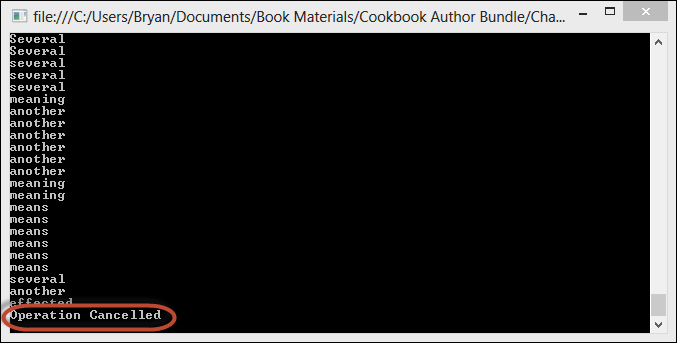As we've seen in previous recipes, to create a task that can be cancelled, you pass in a cancellation token from a CancellationTokenSource object. If you then make a call to the CancellationTokenSource.Cancel method, the token signals all of the tasks that use it should terminate. The linked tasks detect this signal via the token and stop their activity in a safe manner.
Parallel loops support the same cancellation token mechanism as parallel tasks. In a parallel loop, you supply the CancellationToken to the method in the ParallelOptions parameter.
This recipe will download the contents of a book and split the words into a list of strings. We will then use a parallel loop to iterate through the words writing each to the console. However, we will create a separate task that sleeps for a few seconds and then calls the CancellationTokenSource.Cancel method which will cancel the loop.
Let's create a Console Application in Visual Studio so that we can see how to break a loop. The steps are as follows:
- Start a new project using the C# Console Application project template and assign
BreakALoopas the Solution name. - Add the following
usingdirectives to the top of your program class:using System; using System.Linq; using System.Net; using System.Threading; using System.Threading.Tasks;
- First, in the
Mainmethod of the program class, let's create aCancellationTokenSourceand then add theCancellationTokento aParallelOptionsobject.var tokenSource = new CancellationTokenSource(); var options = new ParallelOptions { CancellationToken = tokenSource.Token }; - Next, just below the previous lines, create a simple task that sleeps for a few seconds and then calls the
Cancelmethod on theCancellationTokenSource.Task.Factory.StartNew(() => { Thread.Sleep(new TimeSpan(0,0,5)); tokenSource.Cancel(); }); - Now create a
WebClientto download the text of a book, and split the words from the book into a list of strings.char[] delimiters = { ' ', ',', '.', ';', ':', '-', '_', '/', '"', '(', ')', 'u000A' }; var client = new WebClient(); const string headerText = "Mozilla/5.0 (compatible; MSIE 10.0; Windows NT 6.1; Trident/6.0)"; client.Headers.Add("user-agent", headerText); var words = client.DownloadString(@"http://www.gutenberg.org/files/2009/2009.txt"); var wordList = words.Split(delimiters, StringSplitOptions.RemoveEmptyEntries).Where(word => word.Length > 5).ToList(); wordList.Sort(); - Finally, let's create a simple parallel
foreachloop that writes the strings to the console. The loop should be in a try/catch and we should be catchingOperationCancelledExceptionandAggregateException.try { var loopResult = Parallel.ForEach(wordList, options, (currentWord, loopState) => Console.WriteLine(currentWord)); Console.WriteLine("Loop Completed : {0}", loopResult.IsCompleted.ToString()); } catch (OperationCanceledException) { Console.WriteLine("Operation Cancelled"); } catch (AggregateException) { Console.WriteLine("Operation Cancelled"); } Console.ReadLine(); - In Visual Studio 2012, press F5 to run the project. You should see output similar to the following screenshot:

In this recipe we are using another overload of the Parallel.ForEach method that accepts an IEnumerable source, a ParallelOptions object, and an Action delegate.
ForEach<TSource>(IEnumerable<TSource>, ParallelOptions, Action<TSource>)
The difference between cancelling a task and cancelling a parallel loop is how we pass in the CancellationToken. With a task, a CancellationToken is passed directly into the constructor of the task. For a parallel loop, we set the CancellationToken property of a ParallelOptions
object with our CancellationToken, and then pass the ParallelOptions object into the parallel loop method.
If the token that signals the cancellation is the same token that is set on the ParallelOptions instance, then the parallel loop will throw an OperationCanceledException on cancellation. If a different token causes cancellation, the loop will throw an AggregateException with an OperationCanceledException as an InnerException. Both should be handled in your catch blocks.
